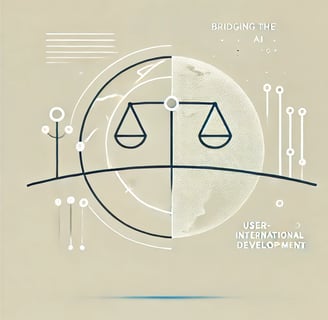Bridging the AI divide: User-centered design in international development
Explore how user-centered design can enhance AI implementation in international development, ensuring sustainable and equitable technological solutions for developing nations.
INTERNATIONAL, UCD AND AI
James Nicholls and Claude
9/12/20243 min read


As artificial intelligence (AI) continues to reshape industries globally, its potential impact on international development is both promising and challenging. Drawing from my experiences with the UN, EU, and various development projects, I've witnessed firsthand the complexities of implementing new technologies in diverse cultural contexts. Today, I'd like to explore how user-centered design (UCD) can enhance AI implementation in international development, ensuring that these powerful tools truly benefit those they're intended to serve.
The AI opportunity in sustainable development
A recent study published in Nature Communications highlights the significant potential of AI in achieving the UN's Sustainable Development Goals (SDGs). The research suggests that AI could enable the accomplishment of 134 targets across all SDGs. However, it also warns that AI may inhibit 59 targets, particularly those related to inequality.
Key findings from the study include:
AI can significantly impact environmental sustainability, potentially supporting 93% of the targets in the Environment group of SDGs.
In the Economy group, AI could benefit 70% of the targets but may negatively affect 33%.
For Society-related goals, AI could enable 82% of the targets while potentially inhibiting 38%.
These statistics paint a complex picture. While AI offers immense potential, its implementation requires careful consideration to avoid exacerbating existing inequalities or creating new ones.
The crucial role of user-centered design
During my time working on public service reform in Nigeria and supporting rule of law initiatives in Kosovo, I learned that the success of any technological intervention hinges on its alignment with local needs, values, and infrastructure. This is where user-centered design becomes crucial.
UCD in the context of AI and international development means:
Engaging local communities in the design process from the outset
Understanding the specific challenges and cultural nuances of each region
Adapting AI solutions to work within existing infrastructures and technological capabilities
Ensuring that AI tools are accessible and beneficial to all segments of the population, not just the tech-savvy elite
Case study: AI in healthcare
Let's consider the potential of AI in improving healthcare outcomes in developing countries. While AI-powered diagnostic tools show promise in enhancing accuracy and efficiency, their successful implementation requires more than just technical excellence.
In Nigeria, for instance, I observed that technological solutions often faltered not due to their capabilities, but because of misalignment with local healthcare practices or lack of necessary infrastructure. A user-centered approach to AI in healthcare might involve:
Collaborating with local healthcare workers to understand their workflow and challenges
Designing interfaces that are intuitive for users with varying levels of technical literacy
Ensuring the AI system can function reliably with intermittent internet connectivity
Incorporating local languages and cultural norms into the system's design
Ethical considerations and governance
As we harness AI for development, ethical considerations must be at the forefront. My experience in Kosovo, working on rule of law initiatives, underscored the importance of robust governance frameworks. When it comes to AI in development, we must address:
Data privacy and security, especially in regions with limited data protection laws
Algorithmic bias and fairness, ensuring AI systems don't perpetuate existing inequalities
Transparency and explainability of AI decision-making processes
Local ownership and capacity building to prevent technological dependency
Looking ahead: A call for collaborative innovation
The intersection of AI, UCD, and international development presents both exciting opportunities and significant challenges. As we move forward, I believe we need:
Greater collaboration between technologists, development practitioners, and local communities
Increased focus on building local AI capabilities in developing countries
Flexible and adaptive governance frameworks that can keep pace with technological advancements
What role do you see for AI in your area of development work? How can we ensure that AI solutions are designed with the end-users in developing countries in mind?
I invite you to share your thoughts and experiences. Together, we can work towards harnessing the power of AI to create meaningful, sustainable change in communities worldwide.
Expertise
User-centered design for digital transformation projects.
Let's chat
Contact me
James@upkurve.com
+44(0)7599175359
© 2024. All rights reserved.
